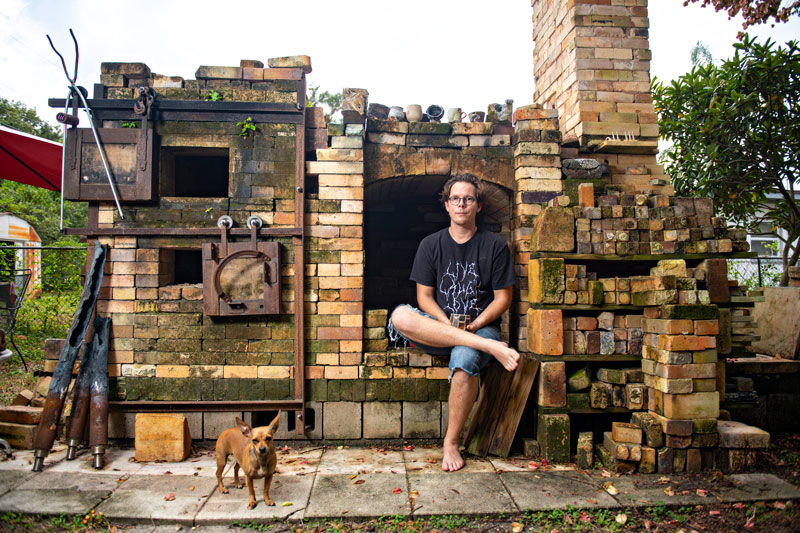
Richard Munster lives with his wife and two children in a midcentury neighborhood on the outskirts of Winter Park. His home dates to an era when people took big backyards for granted, with plenty of room for swing sets, swimming pools, gardens and barbecue pits.
In Munster’s case, make that a shed, a collection of oversized plastic pails filled with earth and clay, three stacks of firewood, a monolithic red-brick monstrosity roughly the size of an SUV and an array of folding tables bearing some of the creations that emerged from it.
Munster is a potter, and the red-brick monster is his kiln — an old-school, wood-fired affair that he built himself.
You can set aside any preconceived associations, literary or otherwise, that the words “potter” and “pottery” may conjure up for you, courtesy of Harry Potter, Beatrix Potter and Pottery Barn.
Munster is a serious artist who creates a broad range of abstract sculptures that wind up in the homes of local collectors. Some of his smaller works — cups that fit into the palm of your hand with deceptive heft, smooth on the inside but honeycombed with sharp planes and mottled with earthy hues on the outside — do look a bit like what the Neanderthals might have used if they’d had time for tea.
Pottery made in an electric or gas kiln is relatively predictable. Pottery that emerges from a wood-fired kiln has both an element of surprise and a primal, organic quality in color and surface texture, thanks to its exposure to a fiery storm of ash generated inside the wood-powered device.
Munster’s obsession with the ancient trade dates back to his years as a disconnected punk-rock devotee, slogging through classes at Bishop Moore High School in the 1990s. “I just couldn’t see the sense of being taught a math formula I knew I’d never use or getting written up for wearing the wrong color socks,” he says.
What he needed was a challenge. It came his way in the form of a newly created, hands-on pottery class taught by the school’s beloved art teacher, Jolie Spelman, who decided to include it in an innovative art practicum that still flourishes under her direction.
She reasoned that the way pottery combines creativity with practicality — or as she puts it, pottery “just wants to be touched and to be used” — would engage students. Munster was one of the first to prove her point.
“Richard was an eager, hungry kid,” she remembers. “He was the kind of student who pushed me, who challenged me as a teacher. That’s what the good ones will do. He would say, ‘Can we make it bigger? Can you do this, can you do that?’”
Munster has been doing this and doing that ever since, first as a hobby, then as a profession, with a degree in visual arts and design from the University of Central Florida.
He later served a stint as an artist-in-residence at the Maitland Art Center and today teaches classes at Valencia College and has a studio at FAVO, an artist collective in a converted motel in the Mills-50 district.
His backyard kiln is made entirely of special bricks designed to stand up to intense heat. A factory that makes the bricks is headquartered in Florida to better serve a steady customer: the Kennedy Space Center, which uses the practically indestructible oblong hunks to help rebuild launch pads.
Munster’s needs are more modest, but in their own way just as intense. Two or three times a year, he gathers up dozens of clay vases, cups and sculptures ready for firing — most of them his, but some representing works by a circle of fellow ceramic artists.
The pottery is loaded into his kiln, known as a “train kiln” because its profile suggests a vintage, coal-fired train engine, one chamber of which is loaded with firewood set alight. Air flow draws the resulting inferno through the adjacent ceramics chamber and then up through the chimney.
“Basically,” says Munster, “it’s a single, continuous, 2,400-degree flame.” For proper glazing to occur, the blaze needs to maintain that temperature for 48 hours straight, hence the need for someone to tend the kiln day and night. Sometimes Munster loads up on coffee and handles the task himself; sometimes members of a small circle of fellow ceramic artists agree to share shifts.
Dan Hess, chief curator of the Maitland Art Center, was invited to attend one of those firings. Hess moved to Central Florida several years ago from New York City, where he was immersed in one of the most vibrant visual-arts scenes in the world.
He misses it, some days more than others, and never expected that a visit to a suburban backyard and a glimpse of faces in firelight would bring back the sense of fierce commitment and camaraderie that he remembered from the city that never sleeps.
“The feeling I got when I walked into that backyard — it stopped me in my tracks,” he says. “That focus, that singular intensity, that sense of community and dedication to an art — it was like walking into a really good restaurant in Soho. You didn’t just feel it. You could smell it in the air.”
Literally and figuratively.
Michael McLeod, mmcleod@rollins.edu, is a contributing writer for Winter Park Magazine.
